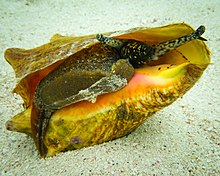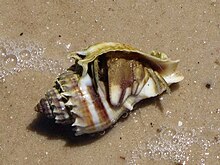
Back صدف حلزونی Persian Trumpa sliogáin Irish Bucina Galician શંખ Gujarati Keong ID 巻貝 Japanese 고둥 Korean Conch SIMPLE சங்கு Tamil శంఖం Tegulu


Conch (/kɒŋk, kɒntʃ/)[1] is a common name of a number of different medium-to-large-sized sea snails. Conch shells typically have a high spire and a noticeable siphonal canal (in other words, the shell comes to a noticeable point on both ends).
In North America, a conch is often identified as a queen conch, indigenous to the waters of the Gulf of Mexico and Caribbean. Queen conches are valued for seafood and are also used as fish bait.[2] In the United States, a rule has been proposed to list the queen conch's conservation status as threatened.
The group of conches that are sometimes referred to as "true conches" are marine gastropod molluscs in the family Strombidae, specifically in the genus Strombus and other closely related genera. For example, Lobatus gigas, the queen conch, and Laevistrombus canarium, the dog conch, are true conches.
Many other species are also often called "conch", but are not at all closely related to the family Strombidae, including Melongena species (family Melongenidae) and the horse conch Triplofusus papillosus (family Fasciolariidae). Species commonly referred to as conches also include the sacred chank or shankha shell (Turbinella pyrum) and other Turbinella species in the family Turbinellidae. The Triton's trumpet (family Charoniidae) may also be fashioned into a horn and referred to as a conch.[citation needed]
- ^ Wells, J. C. (2016). Sounds Fascinating: Further Observations on English Phonetics and Phonology. Cambridge University Press. p. 11. ISBN 978-1-107-15779-8.
- ^ Walters, Martin; Johnson, Jinny (2003). Encyclopedia of Animals. Marks and Spencer. p. 61. ISBN 978-1-84273-964-8.